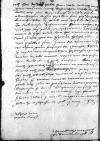List #5875
Johann Albrecht of Brandenburg-Ansbach do Ioannes DANTISCUSAschaffenburg, 1532-05-29
| odebrano Regensburg, 1532-06-04 Rękopiśmienne podstawy źródłowe:
Pomocnicze podstawy źródłowe:
| ||||||
Tekst + aparat krytyczny + komentarz Zwykły tekst Tekst + komentarz Tekst + aparat krytyczny
 AAWO, AB, D.90, f. [1] after f. 112v
AAWO, AB, D.90, f. [1] after f. 112v
Erwyrdigem hern, konigl paper damaged⌈[Erwyrdigem hern, konigl]Erwyrdigem hern, konigl paper damaged⌉icher
zw eyg paper damaged⌈[zw eyg]zw eyg paper damaged⌉nen hand(en)
Erwyrdiger wesunderer gutter her und freundt.
Euer cf.
Wyl ichs umb euch verdinen, / so hore ich gern, das sich
Ich bedanck mich auch gegen den 4 furst(en), so sich so gutbilliglich mit euch zum legat(en) ein furpit fur mich zuthun gen wolt(en) / gehalt(en) haben, / wyls umb sy wyder freuntlich verdinen, / und pit euch, wolt etlichem ein gutt(en) starcken trunck von meynetbegen pringen, damit ir in der geselschafft auch an mich / gedencket. / Auch bedanck ich mich hochlich gegen dem legat(en) des erpitens, Got wel das geschehe, / und ist mein pit mich im zu recome(n)diren. /
Ich wedanck mich auch des geschickten exemplars cf. Ioannes Campensis (Jan Van Campen), Psalmorum omnium iuxta Hebraicam veritatem paraphrastica interpretatio autore Ioanne Campensi, publico, cum nasceretur et absloveretur, Lovanii Hebraicarum literarum professore. R(everendissimo) D(omino) Ioanni Dantisco Episcopo Culmensi etc. dedicata, Norimberga, Ioannes PETREIUS, 1532-05-03 ⌊Psalteriicf. Ioannes Campensis (Jan Van Campen), Psalmorum omnium iuxta Hebraicam veritatem paraphrastica interpretatio autore Ioanne Campensi, publico, cum nasceretur et absloveretur, Lovanii Hebraicarum literarum professore. R(everendissimo) D(omino) Ioanni Dantisco Episcopo Culmensi etc. dedicata, Norimberga, Ioannes PETREIUS, 1532-05-03 ⌋, gefeldt mir wol. Las in hubsch einpint(en) und wyl euer darpey gedencken.
So hab ich euerem wyrdt alhy dem comissario das ein von euertbegen geben mit anczeygung des grusses. Bedanckt sichsn hochlich und wyls mit seinem andechtigem gebethe verdinen.
Es gefallen mir alle ting, wol elandt wan  AAWO, AB, D.90, f. 112v ich hore, das ir superinscribed in place of crossed-out ich⌈ich ir ir superinscribed in place of crossed-out ich⌉ paldt heim wolt, dan ich mich gern vor mit euch besprechen wolt, das dan lader nit sein kann. / Musse es alsodt Gott den almechtigem lassen pefollen sein, pis sein gotliche hidden by binding⌈[e]e hidden by binding⌉ barmhertzikeit dy gnadt mit theyledt, das mir zu
AAWO, AB, D.90, f. 112v ich hore, das ir superinscribed in place of crossed-out ich⌈ich ir ir superinscribed in place of crossed-out ich⌉ paldt heim wolt, dan ich mich gern vor mit euch besprechen wolt, das dan lader nit sein kann. / Musse es alsodt Gott den almechtigem lassen pefollen sein, pis sein gotliche hidden by binding⌈[e]e hidden by binding⌉ barmhertzikeit dy gnadt mit theyledt, das mir zu
Las besolas hidden by binding⌈[s]s hidden by binding⌉ manos da
His paucis feliciter valeat et me illi in perpetuum com<m>endo.
Geben zu
Alzeyt inn euerm dinst


